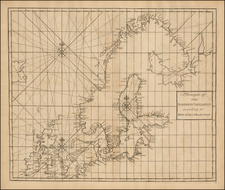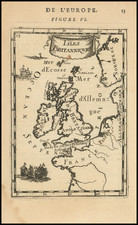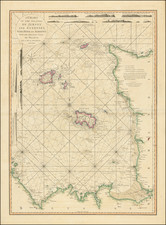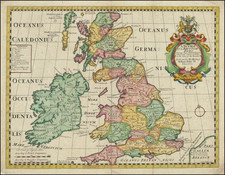Fine example of Rex Whistler's whimsical depiction of the London Stock Exchange.
Whistler's view of the London Exchange highlight both his artist talents and brilliant sense of satire, creating a marvelous charicature of the London market. The map is a marvelous blend or allegory, satire and clever artistry, poking fun at the 21 primary investment opportunities of the day and finished off with a second title cartouche depicting Bull and Bear in contemporary banker's attire.
Rex Whistler (1905-1944) began is career as an artist while still in boarding school at Haileybury, beginning in 1919, where he began to show an unusual talent for art, providing set designs for play productions and giving away sketches to prefects in lieu of "dates" (a punishment at Haileybury, similar to "lines" whereby offenders are required to write out set lists of historical dates).
After Haileybury the young Whistler was accepted at the Royal Academy but disliked the regime there and was "sacked for incompetence". He then proceeded to study at the Slade School of Art where he met The Honourable Stephen Tennant, soon to become one of his best friends and a model for some of the figures in his works.
Upon leaving the Slade, he was an immediate sensation as a professional artist. His work encompassed all areas of art and design. From the West End theatre to book illustration (including works by Evelyn Waugh and Walter de la Mare, and perhaps most notably, for Gulliver's Travels) and mural and trompe l'oeil painting. Paintings at Port Lympne, Plas Newydd and Dorneywood amongst others, show his outstanding talent in this genre.
His most noted work during the early part of his career was for the Cafe at the Tate Gallery, completed in 1927 when he was only 22. He was commissioned to produced posters and illustrations for Shell Petroleum and the Radio Times. He also made designs for Wedgwood china based on drawings he made of the Devon village of Clovelly. Whistler's elegance and wit ensured his success as a portrait artist among the fashionable and he painted many members of London society, including Edith Sitwell, Cecil Beaton and the other members of the set which he belonged to and which became known as the "Bright Young Things".
When war broke out, though he was 35, he was eager to join the army. He was commissioned into the Welsh Guards . His artistic talent, far from being a stumbling block to his military career, was greatly appreciated and he was able to find time to continue some of his work, including a notable self portrait in uniform now in the National Army Museum. In 1944 he was sent to France following the D-Day Landings, where in July, 1944 he was the first fatality suffered by his Battalion in the Normandy Campaign.
Reginald John "Rex" Whistler (1905-1944) was an eminent British artist renowned for his multifaceted contributions to art and design, encompassing murals, society portraits, theatrical costumes, and commercial illustrations. Born into a family with deep artistic and architectural roots, Whistler's early life in Eltham, Kent, set the stage for a vibrant career that intertwined with the cultural fabric of early 20th century Britain.
From a young age, Whistler exhibited a profound artistic talent, which was recognized and nurtured at the Slade School of Fine Art. His work, characterized by its intricate detail and whimsical nature, quickly gained acclaim. Notably, his mural for the Tate Gallery's restaurant, completed in 1927, though now critiqued for its stereotypical imagery, was a testament to his skill and imagination at just 22 years old. This work marked the beginning of a series of prestigious commissions, including those for Shell Petroleum and the Radio Times, and designs for Wedgwood inspired by the pastoral beauty of Clovelly, Devon.
Throughout the 1930s, Whistler's reputation flourished within London’s cultural elite. His portraits and murals captured the essence of the "Bright Young Things," a term denoting a group of bohemian young aristocrats and socialites of that era. His ability to infuse portraits with personality and elegance made him a favorite among figures such as Edith Sitwell and Cecil Beaton. His murals for Edwina Mountbatten’s luxury flat in Park Lane further exemplified his distinct style, which combined classical influences with modern sensibility.
However, Whistler's artistic career was interrupted by World War II. Despite his age and established career, he enlisted in the Welsh Guards, driven by a sense of duty and patriotism. His service was marked not only by bravery but by a continued commitment to art, famously carrying paintbrushes alongside his military equipment. His role as a burial officer, though morbid, underscored his deep respect for his fellow soldiers.
Tragically, Whistler’s life was cut short in 1944 when he was killed in action in Normandy, fulfilling his own poignant premonition of his death. His final act was one of heroism, leaving his tank to aid fellow soldiers. This act not only marked the end of a promising artist but also immortalized him as a figure of courage and sacrifice.
Posthumously, Whistler’s legacy has been preserved through various memorials, including a striking glass engraving by his brother Laurence at Salisbury Cathedral, and an extensive archive of his works held by the Salisbury and South Wiltshire Museum. This collection, which includes thousands of his drawings, designs, and illustrations, was exhibited in 2013, reaffirming his lasting impact on both the artistic and cultural landscapes of Britain.
Whistler’s life and work continue to be celebrated for their artistic merit and his unique contribution to the narrative of British art in the turbulent context of the 20th century.









![[ Letter of Marque ] Articles of Agreement and Engagement of the Privateer or Letter of Marque the Alarm belonging unto the Island of Guernsey . . . 1798](https://storage.googleapis.com/raremaps/img/small/100233.jpg)




![(British Isles) Tabu Moder Anglie & Hiber [Modern Map of England and Ireland]](https://storage.googleapis.com/raremaps/img/small/103164.jpg)